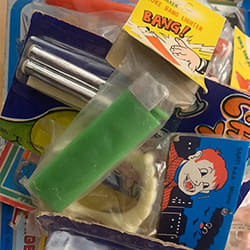The Italians referred to them as “confetti” and explained that they were sugar-coated almonds. They’re so smooth that they slip out of your hand when you try to pick them up individually to eat them.
The outer shell is hard and the insides are too, so they fill your mouth with a gritty feeling once you bite into them. It didn’t leave me with a good impression. I received confetti on several occasions after that, but because of my unpleasant first experience, they just piled up at my house, uneaten.

Confetti is a traditional sweet used during celebrations. You’ll always see them at the close of a wedding ceremony, usually as a gift for the guests. They’re also used at other celebrations, including university graduations and baptisms. Each one has its own color, too—red for university graduates, for example, blue for boys, and pink for girls at baptisms.

At wedding receptions, they pile the confetti in a huge container. It’s customary for guests to just snack on them whenever they like, or even take as many as they want home with them.
Confetti has a long history, and apparently was around as far back as ancient Rome. At first there was no sugar, so the almonds or seeds would be coated in honey. It was considered a convenient snack food among the aristocracy.
Sugar came into widespread use in Italy and started being used to coat confetti around the 15th century. The commercial production of confetti began in a town called Sulmona in the Abruzzo region. If you ask the Italians what they know about the history of confetti, they’ll immediately respond with “Sulmona.” These days, all kinds of manufacturers make endless varieties of confetti, but there are longstanding confetti shops still going strong in their universally-known birthplace.
Confetti’s inseparable companion is the bomboniera, whose name comes from the little French sweets called bonbons. In Italian, bomboniere typically refer to the sweets in a small drawstring pouch or small box—basically making it synonymous with confetti today.
Bomboniere also come in specific colors for each kind of celebration. Graduations have red confetti in a red pouch, for example. It’s common for the pouches to have elaborate decorations and designs, and the fabric itself is always of high quality—so they’re hard to throw away even if you want to get rid of them. Their size and designs aren’t really suited to other uses, either, so to be honest it’s a bit frustrating to receive them.

As an aside, I didn’t realize that the word the Japanese use for small sugary candies, konpeito, comes from the Portuguese word confeito—which is confetti in Italian. Even if the shape and the process of making them are a bit different, both are sugar-coated snacks, so it certainly makes sense!




























































